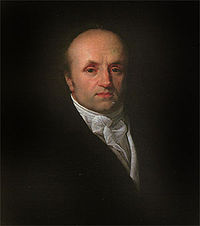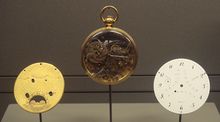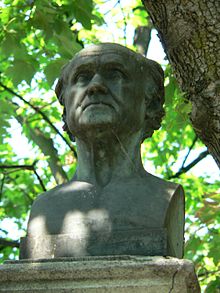- Abraham-Louis Breguet
-
Abraham-Louis Breguet 
Born 10 January 1747
Neuchâtel, SwitzerlandDied 17 September 1823 (aged 76)
Paris, FranceResting place Père Lachaise Cemetery, Paris Occupation Horologist, Inventor Notable works Tourbillon Mechanism Spouse Cécile Marie-Louise L'Huillier ( - 1780) Children Louis-Antoine Breguet Parents Jonas-Louis Breguet ( - 1758)
Suzanne-Marguerite Bollein Breguet watch (1785), bought by the Duc de Choiseul-Praslin. Musée des Arts et Métiers.
Breguet watch (1785), bought by the Duc de Choiseul-Praslin. Musée des Arts et Métiers.
Abraham-Louis Breguet or Bréguet (10 January 1747 – 17 September 1823), born in Neuchâtel in Switzerland, was a horologist who made many innovations in the course of a career in watchmaking in France.
He is the founder of Swiss luxury watch brand Bréguet.
Contents
History
Breguet was born to Jonas-Louis Breguet and Suzanne-Marguerite Bollein. After his father's death in 1758, Breguet's mother remarried Joseph Tattet, who came from a family of watchmakers. Tattet had a showroom in Paris and in 1762 Breguet was sent there to be apprenticed to an unknown master as a watchmaker. Breguet was allowed to marry in 1775 after finishing his apprenticeship. He and his bride, Cécile Marie-Louise L'Huillier, set up their home and the Breguet watchmaking company at 39 Quai de l'Horloge in Île de la Cité in Paris. Breguet invented different escapements, including the tourbillon, automatic winding mechanisms, and the overcoil (an improvement of the balance spring with a raised outer coil). Within ten years Breguet had commissions from the aristocratic families of France and even the French queen, Marie-Antoinette. Cécile died in 1780. He met Abraham-Louis Perrelet in Switzerland and became a Master Clockmaker in 1784. In 1787 Abraham-Louis established a partnership with Xavier Gide, which lasted until 1791.[1]
During the stormy years of the French Revolution (1789–1792), Breguet went into exile in Geneva. His associations with the French monarchy and aristocracy made him a likely target. In 1795, however, Breguet returned to Paris with many ideas for innovations in watch and clock making. He set up business again in Quai de l'Horloge and quickly established a reputation among the new wealthy classes in the Empire. Breguet did not man his workshops in the traditional way, with unskilled apprentices. Instead, he sought out the finest available craftsmen in Paris, who he employed to make watches to his own designs. In the early 19th century Breguet took his son, Louis-Antoine, as a business partner after having sent him to London to study with the great English chronometer maker, John Arnold. Such was the mutual friendship and respect between the two men that Arnold, in turn, sent his son, John Roger, to spend time with Breguet. Breguet met another watchmaker Louis Moinet and recognised his worth at once, and the two men worked closely together. From 1811 on, Louis Moinet became Breguet's personal adviser.
Breguet became a member of the Board of Longitude in 1814 and the following year gained an official appointment as chronometer-maker to the French Navy. He entered the French Academy of Sciences in 1816 as a full member, and received the Chevalier of the Legion of Honour from the hands of Louis XVIII in 1819. Breguet's name is one of the 72 names inscribed on the Eiffel Tower.
The business grew from strength to strength, and when Abraham-Louis Breguet died in 1823 it was carried on by Louis-Antoine.
Influences
Early enthusiasts of Breguet's watchmaking were also Louis XVI and his Queen, Marie-Antoinette. It was one of his pocket watches called the 'Marie Antoinette' which he produced for the Queen which had the most mechanical complications at that period. It was not finished until four years after Breguet's death and over thirty years after that of the Queen. Breguet's most remarkable piece anticipated the wristwatch by two centuries; he designed this, together with his friend John Arnold, for Caroline Bonaparte, Queen of Naples, in 1810. Many honours recognised his enormous contribution to horology. Each watch from his workshops demonstrated the latest horological improvements in an original movement, mostly fitted with lever or ruby-cylinder escapements that he perfected. Breguet took refuge in Switzerland from the excesses of the French Revolution. He returned to Paris overflowing with the ideas that produced the Breguet balance-spring, his first carriage clock (sold to Bonaparte), the sympathique clock and its dependent watch, the tact watch, and finally the tourbillon, patented in 1801.[2]
Apart from the very start of his career, Abraham-Louis Breguet almost always used the calibres of the celebrated Jean-Antoine Lépine, which he transformed. His watches and clocks are widely regarded as some of the most beautiful and technically-accomplished.
Timeline of his works [3]
- 1775-1780 Improved the automatic winding mechanism - his perpetual watch.
- 1783 Invented the gong for repeater watches (bells were used until then). Designed the apple-shaped 'Breguet' hands and 'Breguet numerals'. The hands still grace watch dials today.
- 1787 Adopted and improved the lever escapement. Abraham-Louis Breguet used it in its definitive form from 1814 (this form is still in use).
- 1793 Developed a small watch showing the equation of time.
- 1790 Invented the 'pare-chute' anti-shock device.
- 1794 Invented a retrograde display mechanism.
- 1795 Invented the Breguet spiral (flat spiral balance spring with overcoil).
- 1795 Invented the 'sympathetic' in which a clock rewinds and sets to time a detachable watch.
- 1799 Invented the 'tact' watch that could be read by feel in the pocket or the dark.
- 1801 Patented the tourbillon escapement, developed circa 1795.
- 1802 Invented the echappement naturel, a double-escape wheeled chronometer escapement that needed no oil.
- 1821 Developed the “inking” chronograph, in partnership with Frédérick Louis Fatton.
Generally speaking, Abraham-Louis Breguet was distinguished by the highest attention paid to aesthetic watch design.
See also
References
- ^ "Abraham-Louis Breguet". British Museum. http://www.britishmuseum.org/explore/highlights/article_index/a/abraham-louis_breguet.aspx. Retrieved June 29, 2010.
- ^ "History of Abraham-Louis Breguet". Official Breguet website. http://www.breguet.com/index.php/eng/HISTORY-AND-TRADITIONS/History. Retrieved July 6, 2009.
- ^ "Timeline of Abraham-Louis Breguet". Hautehorlogerie website. http://www.hautehorlogerie.org/en/players/famous-watchmakers/18th-century/abraham-louis-breguet.html. Retrieved July 6, 2009.[dead link]
External links
- Official Breguet watchmakers website
- Works by or about Abraham-Louis Breguet in libraries (WorldCat catalog)
- Breguet's History (in French and English language)
Categories:- 1747 births
- 1823 deaths
- People from Neuchâtel (city)
- Watchmakers (people)
- Clockmakers
- French engineers
- Members of the French Academy of Sciences
Wikimedia Foundation. 2010.


